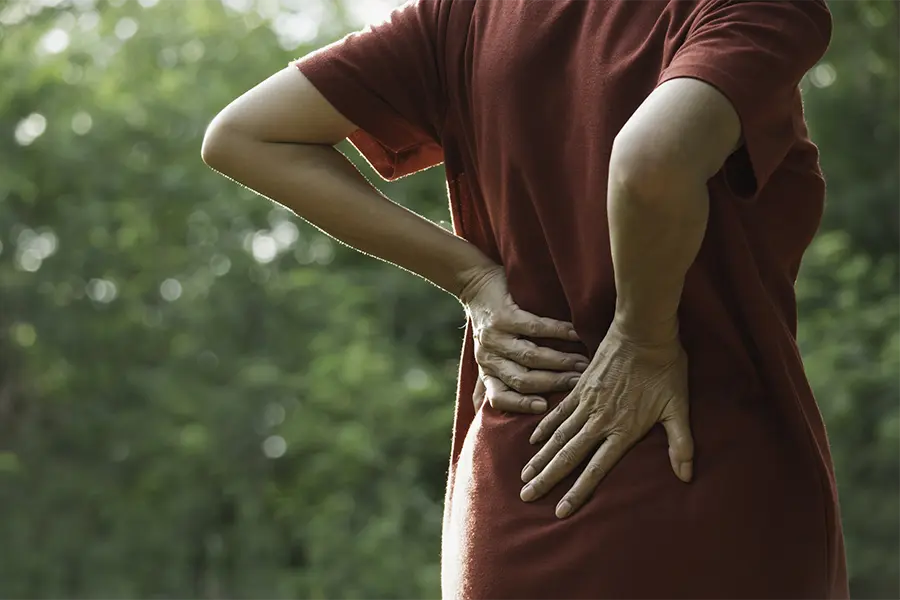
Reducing Back Pain During Perimenopause
Perimenopause isn’t just hot flashes and mood swings. Much how your period can cause back pain, fluctuating hormones can cause aches and even migraines. Declining estrogen affects bones, discs, muscles, and even how the brain processes pain, making back pain and neck pain more common and often more intense. At VSI, our specialists translate cutting-edge research into personalized care so women can stay active and pain-free through every hormonal transition.
How Hormonal Shifts Affect Your Back
1. Estrogen Decline Weakens Bones and Discs
Estrogen normally curbs the cells that break down bone. In the five to seven years around menopause, women lose up to 20% of their bone mineral density (BMD), dramatically raising the risk of bone fractures and osteoporosis-related kyphosis, a common source of chronic mid-back pain.
Low estrogen also dries out intervertebral discs, reducing shock absorption and accelerating disc degeneration that can trigger herniations or sciatica. Recent studies show that estrogen supplementation helps to slow disc breakdown and facet-joint arthritis progression.
2. Muscle and Ligament Changes Reduce Spinal Support
Perimenopausal women lose 1–2% of muscle strength each year after 50, reducing core stability and shifting the extra workload to spinal joints. Estrogen fluctuations may loosen spinal ligaments, increasing joint mobility and mechanical back pain, especially during twisting or prolonged standing. This makes it important to prioritize spine and muscular support in all stages of your life.
3. Central Sensitization Impacts Pain Signals
Estrogen helps regulate serotonin and endorphins. When levels swing or crash, the spinal cord and brain may “turn up the volume,” making normal aches feel unbearable. New imaging studies show greater pain-inhibition deficits in mid-life women, linking hormonal changes to heightened pain sensitivity.
4. The Domino Effect on Your Life
Hormone-related fatigue, poor sleep, and weight gain discourage exercise, weakening muscles and stiffening joints. Added abdominal weight shifts load to the lumbar spine and intensifies low-back stress.
Evidence-Based Strategies to Protect Your Spine
- Schedule a baseline DEXA scan to catch bone loss before fractures occur.
- Combine resistance training with weight-bearing cardio, like brisk walking and hiking, at least three times a week to maintain muscle and stimulate bone.
- Hit daily nutrition targets of calcium, vitamin D, and plenty of anti-inflammatory omega-3 fats.
- Work with a spine-focused physical therapist on core-stability and posture drills to offload stressed discs and joints.
Your Partner in Spine Care
Our multidisciplinary team integrates orthopedic spine with bone-health diagnostics and pelvic-floor rehabilitation to tackle the root causes of pain, not just the symptoms. Whether you’re navigating osteoporosis or recovering from a disc herniation, VSI delivers:
- Advanced Imaging: High-resolution MRI and disc tests for precise spinal analysis.
- Regenerative Options: PRP and stem cell therapy to bolster degenerating discs and joints when conservative care stalls.
- Personalized Movement Plans: Spine-specialized physical therapists who craft safe strength and flexibility programs for every fitness level.
Take the Next Step Toward Pain-Free Living
If hormonal transitions are derailing your active lifestyle, schedule a spine assessment at VSI today. Early intervention preserves bone density, protects discs, and keeps you doing what you love, no matter your stage of life.
Ready to reclaim your life? Call (703)-709-1114 or request an appointment online.
Your spine evolves with your hormones—let VSI® help it age strong.
Topics covered
About the Author
Featured Resources
Insights to Achieve a Pain-Free Life



